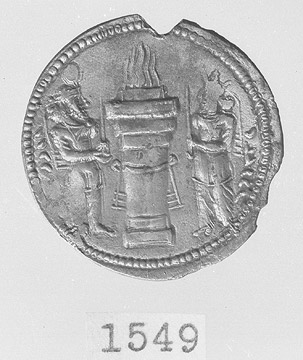Image Resource Bank
Image Gallery |  3 of 15
3 of 15 
Sasanian Coin with Zoroastrian Fire Altar
Zoroastrianism was the official religion of several Iranian empires, including those of the Achaemenids (550-330 BCE), possibly the Parthians or Arsacids (238 BCE-226 CE), and the Sasanians (226-651 CE). Zoroastrians considered light to be the main attribute of the God of Good, Ahura Mazda. They therefore maintained sacred fires in fire-temples where Zoroastrian priests performed a variety of rituals; the fire was not worshipped in itself, but was revered as a symbol of Ahura Mazda (much as Christians revere, but do not worship, the crucifix).
This coin, produced by the Sasanian dynasty that ruled Iran and Iraq from 226 to 651, shows a fire altar with its sacred fire, flanked by two Zoroastrian priests or attendants. The fact that the Sasanians chose to depict a fire-altar on their coinage is an assertion of their claim to be ruling in accordance with Zoroastrian doctrine and with the blessings of the deity. The equation of light with goodness that is characteristic of Zoroastrianism was communicated to other monotheistic faiths; the widespread use, in Christian iconography, of a halo or nimbus of light around the head of sacred figures is one example.
Name: Coin with Zoroastrian Fire Altar
Material: Silver
Size:
Diameter: ca. 2.5 cm (0.98 in)
Date: 226–651 CE, Sasanian Period
Place of Origin: Persepolis
Location: Oriental Institute Museum, Chicago, Illinois
Registration # and Source: Oriental Institute Museum, P61152

 Fred M. Donner
Fred M. Donner
Professor of Near Eastern History, University of Chicago




